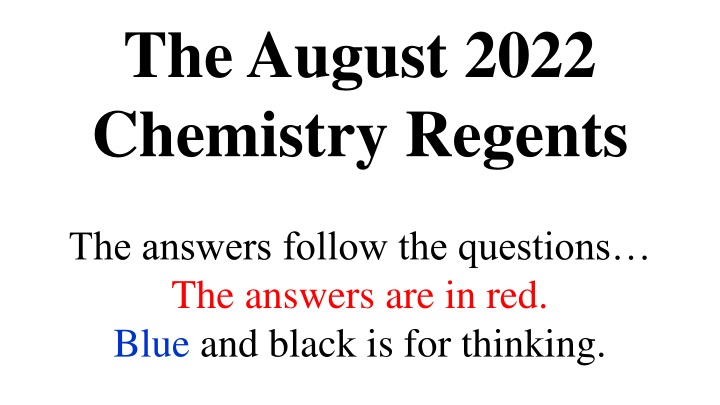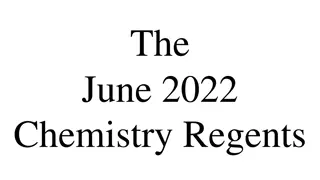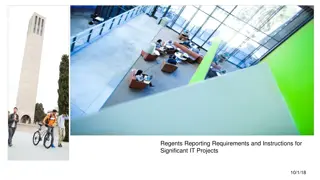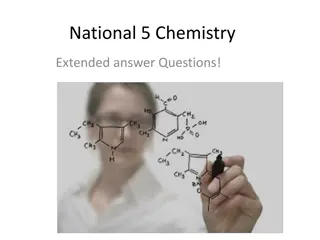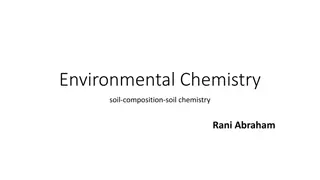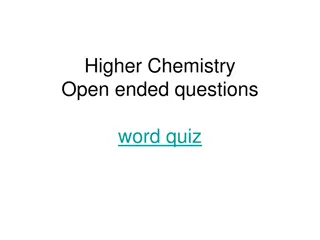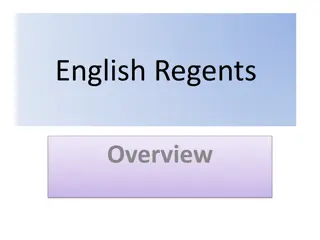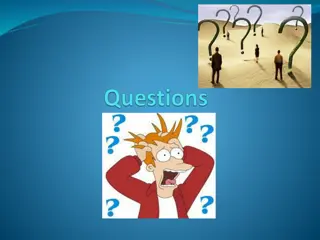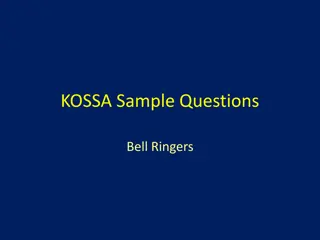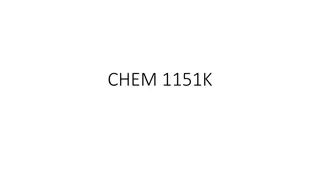Chemistry Regents August 2022: Questions and Answers
Explore the answers to questions from the August 2022 Chemistry Regents exam, covering topics like electron configuration, orbital definition in the wave-mechanical model, and electron energy shells in atoms. Understand concepts such as the number of protons in an atom, orbital definitions, and electron energy levels in potassium atoms.
Download Presentation

Please find below an Image/Link to download the presentation.
The content on the website is provided AS IS for your information and personal use only. It may not be sold, licensed, or shared on other websites without obtaining consent from the author.If you encounter any issues during the download, it is possible that the publisher has removed the file from their server.
You are allowed to download the files provided on this website for personal or commercial use, subject to the condition that they are used lawfully. All files are the property of their respective owners.
The content on the website is provided AS IS for your information and personal use only. It may not be sold, licensed, or shared on other websites without obtaining consent from the author.
E N D
Presentation Transcript
The August 2022 Chemistry Regents The answers follow the questions The answers are in red. Blue and black is for thinking.
1 What is the number of protons in an atom with the electron configuration of 2-5? (1) 5 (2) 2 (3) 3 (4) 7
1 What is the number of protons in an atom with the electron configuration of 2-5? (1) 5 (2) 2 (3) 3 (4) 7 The element with a 2-5 configuration is nitrogen (#7). Nitrogen has an atomic number of 7, which means it has 7 protons that are positive. It also has to have 7 negative electrons. It s mass rounds to 14, which means a total of 14 protons PLUS neutrons. 14 total 7 protons = leaves 7 neutrons. Electrons have no mass in HS.
2 In the wave-mechanical model of an atom, an orbital is defined as (1) a region of the most probable neutron location (2) a region of the most probable electron location (3) the straight-line path of a neutron (4) the straight-line path of an electron
2 In the wave-mechanical model of an atom, an orbital is defined as (1) a region of the most probable neutron location (2) a region of the most probable electron location (3) the straight-line path of a neutron (4) the straight-line path of an electron The modern model is called wave mechanical, because the electrons seem to act as both waves of energy and mechanical bits of negatively charged matter, at the same time. Neutrons are ALWAYS inside of the nucleus. Orbitals are where the electrons live, outside the nucleus.
3 In the ground state, which shell of a potassium atom has an electron with the greatest amount of energy? (1) first (2) second (3) third (4) fourth
3 In the ground state, which shell of a potassium atom has an electron with the greatest amount of energy? (1) first (2) second (3) third (4) fourth K has an electron orbital of 2-8-8-1 The electrons closer to the nucleus, are of lower energy. The further from the nucleus the more energy they have (the wilder they are! So to speak)
4 Which phrase describes two atoms that contain the same number of protons but a different number of neutrons? (1) ions of the same element (2) isotopes of the same element (3) a mixture of different elements (4) nuclides of different elements
4 Which phrase describes two atoms that contain the same number of protons but a different number of neutrons? (1) ions of the same element (2) isotopes of the same element (3) a mixture of different elements (4) nuclides of different elements For example, all atoms of uranium have 92 protons. They all have the SAME atomic number. An isotope is an atom with a different number of neutrons but is the same KIND of atom.
5 All atoms of an element have the same (1) mass number (2) atomic mass (3) number of neutrons (4) number of protons
5 All atoms of an element have the same (1) mass number (2) atomic mass (3) number of neutrons (4) number of protons This is near identical to the last question. All atoms of one element have to have the same atomic number, or number of protons. Mass number, atomic mass, and neutrons change, that is what isotopes are: chemically identical atoms with different numbers of neutrons (and therefore a different mass)
6 Which Group 15 element is classified as a metal? (1) N (2) P (3) As (4) Bi
6 Which Group 15 element is classified as a metal? (1) N (2) P (3) As (4) Bi Fingers in the box time. N is on the right side of the stairs = nonmetal P is on the right side of the stairs = nonmetal As is on the right side of the stairs = nonmetal Bi is on the LEFT side of the stairs = metal The only exception to this rule of the stairs is hydrogen (the freak)
7 Compared to the number of electron shells and radius of an aluminum atom in the ground state, a boron atom in the ground state has (1) fewer electron shells and a smaller radius (2) fewer electron shells and a larger radius (3) more electron shells and a smaller radius (4) more electron shells and a larger radius
7 Compared to the number of electron shells and radius of an aluminum atom in the ground state, a boron atom in the ground state has (1) fewer electron shells and a smaller radius (2) fewer electron shells and a larger radius (3) more electron shells and a smaller radius (4) more electron shells and a larger radius Make a table now WRITE what the table says Boron has fewer shells and a smaller radius. Don t try this in your head. Number of shells or orbitals Radius in pm Al 3 124 B 2 84
8 Hydrogen sulfide, H2S, is classified as a (1) compound with atoms in a fixed proportion (2) compound with atoms in a proportion that can vary (3) mixture with atoms in a fixed proportion (4) mixture with atoms in a proportion that can vary
8 Hydrogen sulfide, H2S, is classified as a (1) compound with atoms in a fixed proportion (2) compound with atoms in a proportion that can vary (3) mixture with atoms in a fixed proportion (4) mixture with atoms in a proportion that can vary Compounds have set formulas, or ratios that are fixed. Mixtures have 2 or more substances NOT BONDED together. With a formula, you are a compound. The H and S are BONDED together, not mixed.
9 A structural formula differs from a molecular formula in that a structural formula shows the (1) arrangement of atoms (2) number of atoms (3) ratio of atoms (4) types of atoms
9 A structural formula differs from a molecular formula in that a structural formula shows the (1) arrangement of atoms (2) number of atoms (3) ratio of atoms (4) types of atoms Let s use butane for an example here, to help you think. Structural formula Molecular formula C4H10 The structural formula is for seeing how a molecule is built . Molecular formulas are for counting and molar mass math. Ratios could be in molecular (or dumb empirical formulas)
10 Which type of reaction occurs when a compound is separated into its elements? (1) synthesis (2) decomposition (3) single replacement (4) double replacement
10 Which type of reaction occurs when a compound is separated into its elements? (1) synthesis (2) decomposition (3) single replacement (4) double replacement Synthesis combines smaller reactants into a larger compound. Decomp it is. One larger reactant breaks down into smaller products. Single Replacement switches in an atom for an ion in solution. Double Replacement does the double switch with 2 AQ solutions
11 Which terms represent two categories of compounds? (1) chemical and physical (2) chemical and molecular (3) ionic and physical (4) ionic and molecular
11 Which terms represent two categories of compounds? (1) chemical and physical (2) chemical and molecular (3) ionic and physical (4) ionic and molecular Chemical and physical refer to changes . A reaction or a phase change. NaCl and CH4 are ionic and molecular compound examples.
12 When an atom of hydrogen and an atom of chlorine combine to form a molecule of hydrogen chloride, a bond is (1) formed as energy is absorbed (2) formed as energy is released (3) broken as energy is absorbed (4) broken as energy is released
12 When an atom of hydrogen and an atom of chlorine combine to form a molecule of hydrogen chloride, a bond is (1) formed as energy is absorbed (2) formed as energy is released (3) broken as energy is absorbed (4) broken as energy is released H + Cl HCl (imagining single atoms instead of diatomic molecules of H2 and Cl2) A bond between H and Cl has to form. When bonds form, energy is released. (this has to be memorized)
13 All atoms of the element vanadium must have the same (1) atomic number (2) mass number (3) number of neutrons plus electrons (4) number of protons plus neutrons
13 All atoms of the element vanadium must have the same (1) atomic number (2) mass number (3) number of neutrons plus electrons (4) number of protons plus neutrons We saw this question earlier twice! All atoms of any element have the same number of protons which means the same atomic number. Neutrons change so neutrons + electrons or neutrons + protons changes with new isotopes. Mass changes too with isotopes, each neutron is 1 AMU, different isotopes = different masses.
14 Which sample of matter can be separated into two different substances by physical means? (1) liquid bromine (2) gaseous propane (3) solid sodium acetate (4) aqueous magnesium sulfate
14 Which sample of matter can be separated into two different substances by physical means? (1) liquid bromine >>> this is an element (2) gaseous propane >>> this is a compound (3) solid sodium acetate >>> this is a compound (4) aqueous magnesium sulfate >>> this is a mixture Pure matter, elements and compounds are not mixed. Elements are the simplest of the pure substances and cannot be broken down at all. Compounds can be chemically broken down into elements. An aqueous solution is water with stuff mixed into it. Here, the water can be evaporated away, separating the water from the MgSO (S)
15 Two liquids can be separated by distillation due to a difference in (1) concentration (2) conductivity (3) boiling point (4) heat of fusion
15 Two liquids can be separated by distillation due to a difference in (1) concentration (2) conductivity (3) boiling point (4) heat of fusion Concentration is how much stuff is present in solution. Conductivity means how well a substance can conduct either heat or electricity (or sound, etc.), and heat of fusion means how many joule of energy it takes to either melt or freeze one gram of this stuff at it s freezing point. Separating a mixture by difference in boiling point is called distillation.
16 Which unit can be used to express the concentration of a PbCl2(aq) solution? (1) kelvins (2) kilojoules per gram (3) pascals (4) parts per million
16 Which unit can be used to express the concentration of a PbCl2(aq) solution? (1) kelvins (2) kilojoules per gram (3) pascals (4) parts per million Put your finger into the concentration box on the back page of the reference table S now. Molarity is much more common, but for especially weak solutions, PPM is also used. Kelvin is temperature, kJ/gram is energy per gram and is NOT on the reference tables. Pascals is pressure, as kilopascals or kPa.
17 Compared to the freezing point and boiling point of water at 1.0 atm, a 0.5 M aqueous solution of NaCl at 1.0 atm has (1) a lower freezing point and a lower boiling point (2) a lower freezing point and a higher boiling point (3) a higher freezing point and a lower boiling point (4) a higher freezing point and a higher boiling point
17 Compared to the freezing point and boiling point of water at 1.0 atm, a 0.5 M aqueous solution of NaCl at 1.0 atm has (1) a lower freezing point and a lower boiling point (2) a lower freezing point and a higher boiling point (3) a higher freezing point and a lower boiling point (4) a higher freezing point and a higher boiling point Make a chart, write what you find. SAY: the NaCl solution has Freezing point Boiling point Water 273 K or 0 C 373 K or 100 C NaCl(AQ) Lower Higher 1.86 C/mole particles dissolved per liter 0.5 C/mole particles dissolved per liter Impact The FP and BP are known for pure water. Whenever stuff is dissolved into water, there are changes to colligative properties like FP and BP. Here the freezing point is depressed, and the boiling point is elevated.
18 Which form of energy is converted to thermal energy when propane burns in air? (1) chemical (2) electrical (3) mechanical (4) nuclear
18 Which form of energy is converted to thermal energy when propane burns in air? (1) chemical (2) electrical (3) mechanical (4) nuclear Chemical energy (energy stored in the bonds is converted into heat energy when combustion occurs. Propane is a hydrocarbon, combining with oxygen in the air, it forms water and carbon dioxide gases. H is negative, energy is a product.
19 According to the kinetic molecular theory, which statement explains why an ideal gas can be compressed to a smaller volume? (1) The motion of the gas particles is circular and orderly. (2) The force of attraction between the gas particles is strong. (3) As the gas particles collide, the total energy of the system decreases. (4) The gas particles are separated by great distances relative to their size.
19 According to the kinetic molecular theory, which statement explains why an ideal gas can be compressed to a smaller volume? (1) The motion of the gas particles is circular and orderly. (2) The force of attraction between the gas particles is strong. (3) As the gas particles collide, the total energy of the system decreases. (4) The gas particles are separated by great distances relative to their size. This is true for both ideal and for real gases. Gas particles are crazy small, and gases are MOSTLY empty space. You can squish a roomful of gas into a very small sized bottle because the particles of the gas are super small, and the empty space gets compressed. You end up with much higher pressure, because with so little space there are many more collisions, and collisions cause gas pressure.
20 Under which conditions of temperature and pressure does a sample of propane behave least like an ideal gas? (1) 250. K and 1.0 atm (2) 250. K and 5.0 atm (3) 500. K and 1.0 atm (4) 500. K and 5.0 atm
20 Under which conditions of temperature and pressure does a sample of propane behave least like an ideal gas? (1) 250. K and 1.0 atm (2) 250. K and 5.0 atm (3) 500. K and 1.0 atm (4) 500. K and 5.0 atm Write the answer first. Hot gases are more ideal, so COLD GASES ARE LESS IDEAL, they are more likely to collapse into a liquid, then, lower pressure gases are more ideal, so HIGH PRESSURE GASES ARE LESS IDEAL, the more collisions means the more likelihood of collapsing into a liquid.
21 Compared to a 1.0-L sample of CO2(g) in a sealed, rigid container at STP, a 1.0-L sample of CH4(g) in a sealed, rigid container at STP has the same (1) density (2) molar mass (3) chemical properties (4) number of molecules
21 Compared to a 1.0-L sample of CO2(g) in a sealed, rigid container at STP, a 1.0-L sample of CH4(g) in a sealed, rigid container at STP has the same (1) density (2) molar mass (3) chemical properties (4) number of molecules This is the Avogadro s Hypothesis question. Equal volumes of different gases, at the same temp and pressure have the same number of moles and the same number of particles. 1.0 Liters of 2 different gases at the same temp and pressure have the same number of moles of gas and the same number of particles of gas (molecules are particles)
22 A chemical reaction occurs when (1) H2O(G)forms H2O(L) (2) H2O(L)forms H2O(S) (3) O2(L) forms O2(S) (4) O2(g)forms O3(g)
22 A chemical reaction occurs when (1) H2O(G)forms H2O(L) (2) H2O(L)forms H2O(S) (3) O2(L) forms O2(S) (4) O2(g)forms O3(g) One is a phase change Two is a phase change Three is a phase change Four is chemical, something new forms oxygen becomes ozone.
23 What is the purpose of adding a catalyst to a chemical reaction? (1) to decrease the potential energy of the products (2) to increase the potential energy of the reactants (3) to convert solid reactants to liquid reactants (4) to provide an alternate reaction pathway
23 What is the purpose of adding a catalyst to a chemical reaction? (1) to decrease the potential energy of the products (2) to increase the potential energy of the reactants (3) to convert solid reactants to liquid reactants (4) to provide an alternate reaction pathway Catalysts make reactions go faster by lowering the activation energy, or by providing an alternate chemical pathway (a shortcut), or both. Either of these means that a reaction gets to start quicker, which also makes the reaction happen faster.
24 Systems in nature tend to undergo changes toward (1) lower energy and less disorder (2) lower energy and greater disorder (3) higher energy and less disorder (4) higher energy and greater disorder
24 Systems in nature tend to undergo changes toward (1) lower energy and less disorder (2) lower energy and greater disorder (3) higher energy and less disorder (4) higher energy and greater disorder Another standard regents question. Disorder is entropy. Nature breaks down, creating more disorder. Energy gets used, or spreads out, it does not come back together easily. Mountains crumble to the sea. Energy fades away, in the end there will be almost nothing everywhere, and no energy to put Humpty Dumpty back together again.
25 Which reaction occurs at the anode in an electrochemical cell? (1) neutralization (2) oxidation (3) reduction (4) substitution
